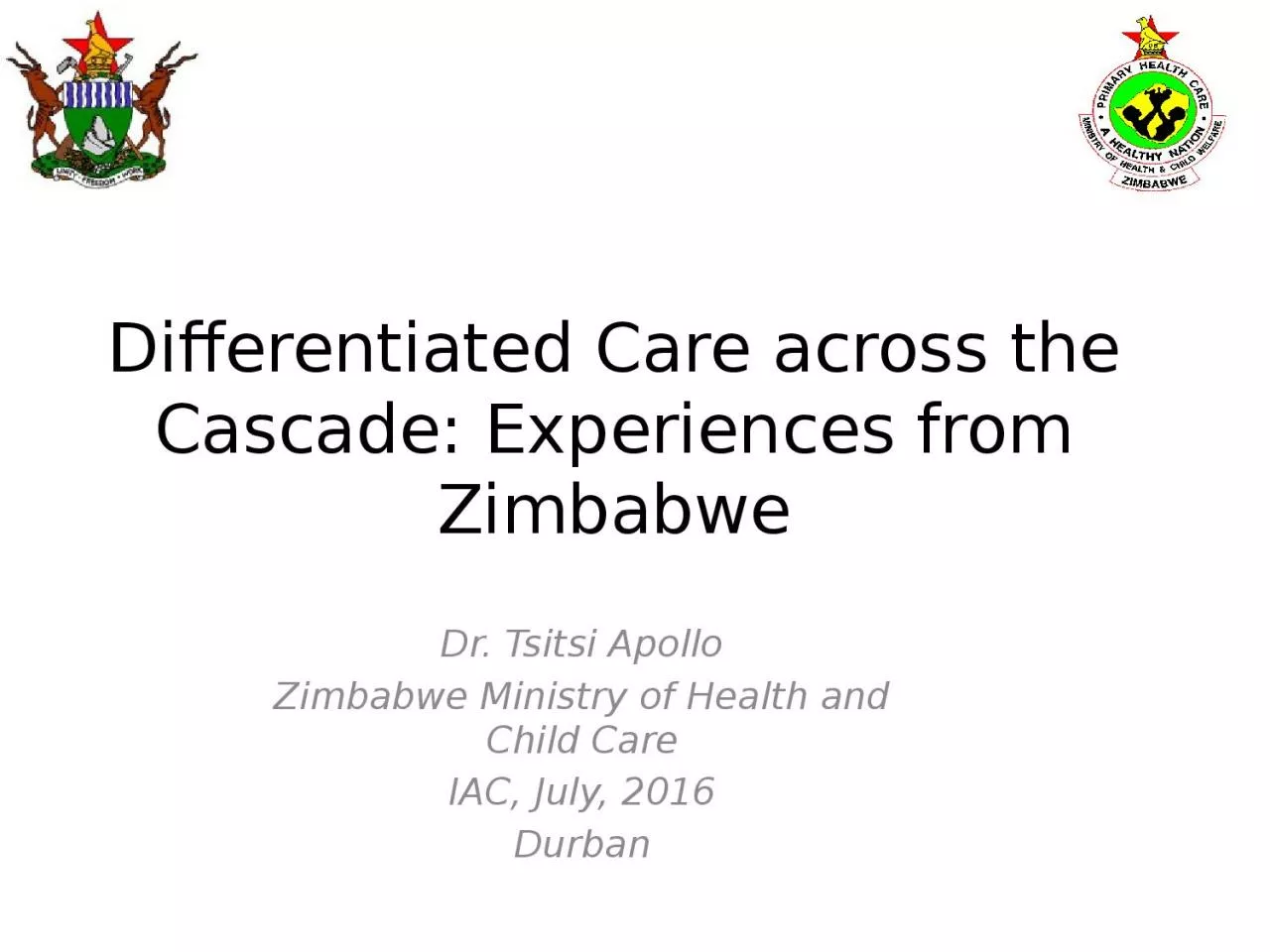

Dr Tsitsi Apollo Zimbabwe Ministry of Health and Child Care IAC July 2016 Durban Presentation Outline Background Zimbabwe population 13 million Generalized HIV epidemic with prevalence 147 ID: 1041797
Download Presentation The PPT/PDF document "Differentiated Care across the Cascade: ..." is the property of its rightful owner. Permission is granted to download and print the materials on this web site for personal, non-commercial use only, and to display it on your personal computer provided you do not modify the materials and that you retain all copyright notices contained in the materials. By downloading content from our website, you accept the terms of this agreement.
1. Differentiated Care across the Cascade: Experiences from ZimbabweDr. Tsitsi ApolloZimbabwe Ministry of Health and Child CareIAC, July, 2016Durban
2. Presentation Outline
3. Background:Zimbabwe population: 13 millionGeneralized HIV epidemic with prevalence: 14.7%HIV incidence: 0.88%# of PLHIV: 1,4 m including 77,000 childrenHigh TB/HIV co-infection rate: 69%
4. Background:Number of PLHIV on ART: 891,621 (March, 2016)Adults coverage (61%) Children coverage (80%)Retention on ART at 12 monthsMales 87%Females 88%Viral Suppression: 89,5%at 12 months (HIV DR Resistance Survey, 2012)
5. Rationale for Differentiated Care:
6. Process:July, 2014April, 2015Oct, 2014 –March, 2015June, 2015August, 2015
7. -Developed to support the implementation of the WHO 2013 HIV Guidelines-User-friendly and clearly articulates the ‘how to’ deliver services -Defines the minimum package across the prevention, treatment and care cascade-Defines roles and responsibilities of the different cadres including community-Identifies operational strategies that aim to address leakages in the cascade -Highlights special considerations for children, adolescents, pregnant and lactating women
8. Differentiated ART Delivery:Source: C. Duncombe Frame-work to delivering HIV care and treatment (TMIH, April 2015)Four levels to adapt care to people’s needs
9. 1. Service Intensity:Provision of different service package according to the health status of the patientPatients with low CD4 cell count <100 cells/mm3ART Initiation Lab testHaemoglobin for AZTCreatinine clearance for TDFRefills:Individual refill from pharmacyFamily ‘ART’ Group’ refillGroup ‘club’ refillCommunity ART Group refillsInvolvement of networks of PLHIV in the determination of appropriate models and development of standard tools for implementing differentiated care
10. Community ART refill groupsModelself-selecting patient groups (6-12) one representative picks up ARVs for the group on quarterly basisgroup contribute money for transport/ lunch/in kind support (eg work their fields) Results: 9 months pilot evaluation (n=207)100% retention, 99% virally suppressedTime saving: normally 45mins waiting, 50 mins with staff (nurse, counsellor, pharmacist); ART refill groups: 30 mins to serve 8 patients Secondary benefits in increased resilience, reduced stigma, more participation in health governance.Source: MSF, 2014
11. 2. Service Frequency:Stable adult clients on ART being monitored clinically +/- immunologically are seen 6 monthly for clinical visitsA stable client is defined as one withno concurrent illnesshas a VL < 1,000 copies/ml at least 6 months on ARTClinics schedule 3-monthly refill visitsAppointment diaries +/- electronic patient management system- generated appointment lists in use to support tracking of clients and defaulters Infants are followed up monthly until 18 months, thereafter 3-monthly Children are seen 3-monthly until transitioned to adult ARV doses with 6-monthly visitsBF & PW have their clinic visit schedule synchronized and integrated into MNCH services
12. 3. Service location:Decentralization of ART services Integration of ART/TB servicesEasier at lower level facilitiesStrong referral systems required at higher levelsOffering PMTCT services in MNCH platformCommunity-level servicesCSS Framework for health sector being developedCommunity worker’s role in adherence and psychosocial support and defaulter trackingNational Health Strategy has provision of establishment of ‘Health Posts’
13. 4. Type of Health Worker:Primary Care Nurses: lower level cadres (18 month training post O-Level education); manning primary care clinicPrimary Counsellors: Lay counsellors (9 month training); conduct HTS services including RDT for HIV Community health workers: Village Health WorkersOver 87,000 community healthy workers77 different types of community cadresCapacity building of HR: HIV Integrated training package (supports provision of integrated services eg TB/HIV, HIV/SRH), psychosocial support for children & adolescents LHIV
14. Patient:
15. Critical enablers:Explicit national guidelines/SOPs on ‘Differentiated Care’Engage with key stakeholders especially networks of PLHIV for demand creationSecure adequate resources for sensitization & training buffer stock of medicinesDevelop an M & E planMonitoring toolsConsider integration with quality improvement initiatives
16. Conclusions:Differentiated care is anticipated to : Provide targeted interventions to specific type of patients who would otherwise not have their needs fully metFoster ‘patient-centric’ or ‘patient-oriented’ care delivery modelsAlleviate the burden on the already overstretched health systemNeed to identify strategies to address retention among ‘well patients’
17. I Thank You